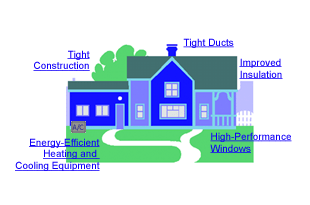Fall Home Maintenance Checklist
10 SeptemberAs the fall season nears, protecting our homes from the cooler weather is an important step in home ownership. With the fall and winter comes more rain and cooler temperatures. Here are 8 maintenance tips that can be completed over the weekend. These tasks will prepare your home for the change of season as well as reduce the chance of needing a major repair.
- Heating System Tune up. For a minimal charge of $80-$100 an HVAC contractor can check your heating system to ensure optimal performance and discover minor problems before they turn into costly major repairs. It is also a great time to change your furnace filter. You may want to consider getting your ducts cleaned as well.
- Roof and Gutters. Gutters clogged with leaves can quickly damage a homes foundation. Clean gutters and make sure they drain completely. Also consider walking the roof to look for leaks or damaged shingles. Only do these tasks if you are comfortable on ladders and working on the roof, otherwise hire a professional.
- Caulking and Paint. Fall is a great time to check for cracked or damaged caulk around your windows and doors. Moisture can quickly leak into these cracks and reek havoc. Any chipped or damaged paint should be scraped, primed, and repainted.
- Downspout Extensions. Make sure your downspouts are extended to move water 4-5 Feet away from the foundation. This is an important step any time but especially the fall and spring as this tends to be the wettest part of the year.
- Trim Landscaping. Trim your bushes and shrubs so they are 1 foot away from the surface of the home. This allows for proper air flow and lets the area dry out. Also clean any leaves and debris from around the foundation.
- Disconnect Water Hose. This will help prevent your water line to the hose from freezing.
- Chimney. Great time of year to call a qualified chimney sweep to clean and inspect your chimney. This could prevent a dangerous and costly repair. Do not light your fireplace without an annual inspection to ensure your safety.
- Crawl Space. We tend to forget about the crawlspace because we hate getting in there. This time of year is a great time to get in the crawl space to make sure there is no trouble. Check your vapor barrier, sump pumps, look for water or insect damage.
Fall is a great time for an annual home inspection. Look to New Start Inspections to inspect your home this fall. We want to help you protect your home as it is your greatest investment.
The building parts of an Energy Efficient House
21 OctoberWhat you need for an energy efficient house.
Part 1 - Building and Designing
Building and designing an energy-efficient home that conforms to the many considerations faced by home builders today can be a big challenge. However, any house style can be made to require relatively minimal amounts of energy to heat and cool, and be comfortable and healthy if this is taken into consideration from the start.
 It’s easier now to get your architect and builder to use improved designs and construction methods. Even though there are many different design options available, they all have several of the following things in common: a high R-value, tightly sealed thermal envelope; controlled ventilation; and lower than usual heating and cooling bills. Some designs are more expensive to build than others, but none of them need to be extremely expensive to construct. Recent technological improvements in building elements and construction techniques, and heating, ventilation, and cooling systems, allow most modern energy saving ideas to be seamlessly integrated into any type of house design without sacrificing comfort, health, or aesthetics.
It’s easier now to get your architect and builder to use improved designs and construction methods. Even though there are many different design options available, they all have several of the following things in common: a high R-value, tightly sealed thermal envelope; controlled ventilation; and lower than usual heating and cooling bills. Some designs are more expensive to build than others, but none of them need to be extremely expensive to construct. Recent technological improvements in building elements and construction techniques, and heating, ventilation, and cooling systems, allow most modern energy saving ideas to be seamlessly integrated into any type of house design without sacrificing comfort, health, or aesthetics.
The following is a discussion of the major elements of energy-efficient home design and construction
The Thermal Envelope
A “thermal envelope” is everything about the house that serves to shield the living space from the outdoors. It includes the wall and roof assemblies, insulation, windows, doors, finishes, weather- stripping, and air/vapor retarders. Specific items to consider in these areas are described below.
Wall and Roof Assemblies
There are several alternatives to the conventional “stick” (wood stud) framed wall and roof construction now available and growing in popularity. They include:
-
Optimum Value Engineering (OVE)
This is a method of using wood only where it does the most work, thus reducing costly wood use and saving space for insulation. However, workmanship must be of the highest order since there is very little room for construction errors.
-
Structural Insulated Panels (SIP)
These are generally plywood or oriented strand board (OSB) sheets laminated to a core of foam board. The foam may be 4 to 8 inches thick. Since the SIP acts as both the framing and the insulation, construction is much faster than OVE or it’s older counterpart “stick-framing.” The quality of construction is often superior too since there are fewer places for workers to make mistakes.
-
Insulating Concrete Forms (ICF)
These often consist of two layers of extruded foam board (one inside the house and one outside the house) that act as the form for a steel reinforced concrete center. This is the fastest and least likely technique to have construction mistakes. Such buildings are also very strong and easily exceed code requirements for tornado or hurricane prone areas.
Insulation
An energy-efficient house has much higher insulation R-values than required by most local building codes. It is important to remember that these are minimum standards. For example, a typical house in New York State might have haphazardly installed R-11 fiberglass insulation in the exterior walls and R-19 in the ceiling, and the floors and foundation walls may not be insulated. A similar, but well-designed and constructed house’s insulation levels would be in the range of R-20 to R-30 in the walls (including the foundation) and R-50 and R-70 in the ceilings. Carefully applied fiberglass batt or roll, wet-spray cellulose, or foam insulations will fill wall cavities completely.
Air / Vapor Retarders
These are two things that sometimes can do the same job. How to design and install them depends a great deal on the climate and what method of construction is chosen. No matter where you are building, water vapor condensation is a major threat to the structure of a house. In cold climates, pressure differences can drive warm, moist indoor air into exterior walls and attics. It condenses as it cools. The same can be said for very Southern climates, just in reverse. As the humid outdoor air enters the walls to find cooler wall cavities it condenses into liquid water. This is the main reason why some of the old buildings in the South that have been retrofitted with air conditioners now have mold and rotten wood problems.
Regardless of your climate, it is important to minimize water vapor migration by using a carefully designed thermal envelope and sound construction practices. Any water vapor that does manage to get into the walls or attics must be allowed to get out again. Some construction methods and climates lend themselves to allowing the vapor to flow towards the outdoors. Others are better suited to letting it flow towards the interior so that the house ventilation system can deal with it.
The Airtight Drywall Approach and the Simple CS system are other methods to control air and water vapor movement in a residential building. These systems rely on the nearly airtight installation of sheet materials such as drywall or gypsum board on the interior as the main barrier, and carefully sealed foam board and/or plywood on the exterior.
Foundations and Slabs
Foundation walls and slabs should be at least as well insulated as the living space walls. Uninsulated foundations have a negative impact on home energy use and comfort, especially if the family uses the lower parts of the house as a living space. Also, appliances that supply heat as a by-product, such as domestic hot water heaters, washers, dryers, and freezers, are often located in basements. By carefully insulating the foundation walls and floor of the basement, these appliances can assist in the heating of the house.
Windows
The average home loses over 25% of its heat through windows. Since even new modern windows insulate less than a wall, in general an energy-efficient home in heating dominated climates should have few windows on the north, east, and west exposures. A rule-of-thumb is that window area should not exceed 8-9% of the floor area, unless your designer is experienced in passive solar techniques.
In cooling dominated climates, its important to select east, west, and south facing windows with low solar heat gain coefficients (these block solar heat gain). A properly designed roof overhang for south-facing windows is important to avoid overheating in the summer in most areas of the continental United States. Energy Star rated windows or better should be used, according to the Energy Star regional climatic guidelines.
In general, the best sealing windows are awning and casement styles since these often close tighter than sliding types. Metal window frames should be avoided due to the condensation that occurs, especially in cold climates. Always seal the wall air/vapor diffusion retarder tightly around the edges of the window frame to prevent air and water vapor from entering the wall cavities.
Air-Sealing
A well-constructed thermal envelope requires that insulating and sealing be precise and thorough. Sealing air leaks everywhere in the thermal envelope reduces energy loss significantly. Good air-sealing alone may reduce utility costs by as much as 50% when compared to other houses of the same type and age. Homes built in this way are so energy-efficient that specifying the correct sizing heating/ cooling system can be tricky. Rules-of-thumb system sizing is often inaccurate, due to the difference between an air tight home and an older type construction, resulting in oversizing and wasteful operation.
**More to follow on this topic soon




